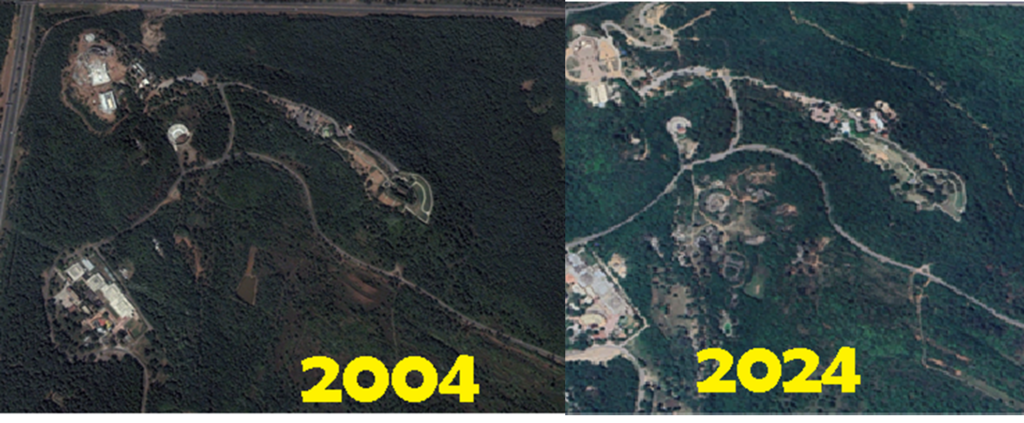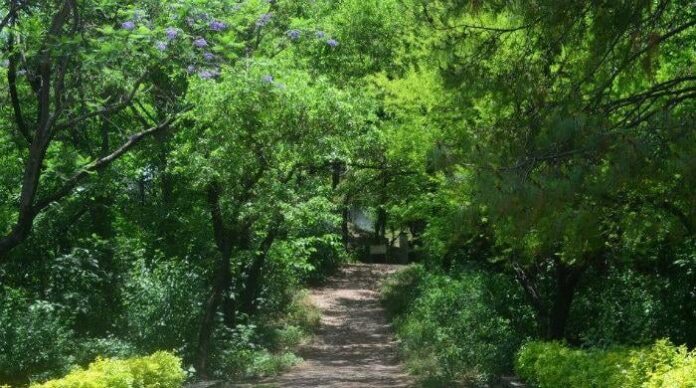Since its designation as Pakistan’s capital in 1963, Islamabad has experienced exponential growth and urbanization, with its population surging from 0.117 million in 1961 to 2.4 million by 2023. The city’s favorable climate, abundant green spaces, accessible healthcare and educational facilities, and modern amenities appeal to both people residing inside the country and expatriates.
However, this rapid growth has exacted a severe environmental cost, with the city’s urbanization leading to significant changes in land use and ecological balance, deforestation, habitat loss, and disruption of its vital ecosystems. The replacement of natural land cover with impermeable urban materials has contributed to changing local climates, increased energy consumption, and affected air and water quality.
Islamabad’s rapid urbanization makes it one of the fastest expanding cities in Pakistan but the conversion of croplands, grasslands, and forests into urban structures poses significant environmental challenges. It highlights the need for sustainable urban planning and management practices to mitigate the negative impacts on the city’s ecology and residents.
The Tragic Tale of Islamabad’s Urbanization
Islamabad, a city once known for its lush green landscapes and pleasant climate, now suffers from the devastating consequences of uncontrolled urbanization. Between 1961 and 2024, the city has experienced an alarming temperature rise of 5°C, with projections indicating a further rise of 0.7°C by 2039 and 2.2°C by 2069. The urban heat island effect has turned the city into a scorching hotbed.
A City Drowning in Its Own Development
The unchecked growth of Islamabad has led to a plethora of environmental disasters. The city’s sprawling landscape has exacerbated traffic congestion, greenhouse gas emissions, and air pollution. The replacement of natural surfaces with impermeable ones has made the city vulnerable to urban floods. The tragic consequences of this were evident in the E-11 sector, where a cloudburst triggered a flash flood, claiming the lives of a mother and her child. The city’s drainage systems, overwhelmed by the rapid urbanization, were unable to cope with the deluge, leaving residents to face the devastating aftermath.
Shakarparian: A Historical and Ecological Treasure Trove of Islamabad
I worked for Capital Development Authority (CDA) for a short time in 2007. My task was to evaluate the spillway of Simly Dam and the future water supply of Islamabad. I was curious to know how the Greek firm of architects, led by Konstantinos Apostolos Doxiadis, designed the city’s master plan in 1960 and also designed the water supply system. All the records of the master plan were placed at Bazar Road Iqbal Hall G-7.
While going through the record, I got to read about the role of Shakarparian Hills, a triangle-shaped green area near the Zero Point Interchange in Islamabad, Pakistan. In the original master plan, it was popularly perceived as a temperature regulator and a sound barrier and referred to as an urban lung in a polluted urban environment. It is also believed that Shakarparian has an important role in regulating and supplying the groundwater to the city. Shakarparian has an area of 1376 hectares and was also declared an integral part of Margalla Hills National Park in 1980. The Shakarparian Park is an emerald jewel in the crown of Islamabad’s clean environment, being located almost in the center of the city. In the original master planning, Shakarparian Forest was declared a protective forest for the clean environment of Islamabad
Faunal Diversity in Shakarparian Forest
A biodiversity assessment conducted in Shakarparian in November 2014 revealed a diverse range of animal species. The study recorded a total of 155 animal species, comprising 23 species of mammals, 104 species of birds, 22 species of reptiles, and 6 species of amphibians. Notably, the avifauna of Shakarparian comprised 104 species of birds, representing 16 orders, 42 families, and 73 genera.
Floristic Diversity and Dominant Vegetation Communities
The same study also documented a rich floristic diversity in Shakarparian, with over 661 plant species observed belonging to 28 different families. The dominant plant families included Fabaceae, Poaceae, Acanthaceae, and Euphorbiaceae. The study identified six dominant vegetation communities, namely Cynodon dactylon, Carissa opaca, Justicia adhatoda, Lantana camara, Cassia fistula, and Dodonaea viscose. These findings highlight the significance of Shakarparian as a biodiversity hotspot in the region.
Roedad Khan, the legendary Pakistani politician and civil servant established, the Margalla Hills Society (MHS) in early 1989 to preserve the natural environment of Margalla Hills National Park and prevent the shrinkage of the green areas. So far, the Margalla Hills Society (MHS) is doing a wonderful job to protect Margalla Hills.
However, Shakarparian Forest continuously became a victim of CDA decisions, and many buildings, including the leasing of land to various private and public entities, have changed the land use of Shakarparian Forest. These uneven developments not only spoiled this ancient forest but were one the main causes of the rising temperature of Islamabad

The CDA management has been accused of leasing out forest lands to private parties for hotels and restaurants, despite this being a clear violation of Regulation 4(3)(b) of the ICT Zoning Regulations of Islamabad. This decision was allegedly made under political pressure, compromising the environmental integrity of the area.

Satellite images captured by Landsat and Sentinel over the past 20 years reveal a striking transformation in land use patterns in the southwest region of Shakarparian forest. This period has witnessed widespread deforestation, with vast areas of forestland being cleared for urban development, like restaurants and monuments, resulting in the expansion of built-up areas and the destruction of natural habitats. The images demonstrate a notable increase in urban footprint, highlighting the profound impact of human activities on the forest ecosystem and biodiversity, ultimately emphasizing the need for sustainable land use planning and conservation efforts to protect this vital natural resource.
The Islamabad High Court verdict on January 11, 2022, in the case of Prof. Zahid Baig Mirza versus Capital Development Authority, further emphasizes the illegality of such actions. The court ruled that even the shifting of the Parade Ground to Zone 3, along with road widening and construction of the China Friendship Centre in Shakarparian forest, violates the ICT Zoning Regulations.
To address these concerns, several recommendations have been proposed to preserve the Shakarparian Forest:
- Relocation of Islamabad Club: The club has expanded beyond its original allotment and should be shifted to the southern side of Islamabad.
- Cancellation of Leases: All leases granted for hotels, restaurants, and other developments in the forest area should be canceled to restore the natural ecosystem.
- Shifting Government Buildings: Government buildings in the forest area should be relocated to a new sector of Islamabad, as per IMF instructions.
- Shelving the Cricket Stadium Construction: The proposed construction of a cricket stadium in Shakarparian Forest poses a potentially catastrophic threat to Islamabad’s environmental health and should be avoided.
Dear residents of Islamabad, let’s work together and save Shakarparian forest for clean air and a cooler Islamabad. As residents of Islamabad, we must safeguard our city’s environmental heritage. Let us join hands and urge the authorities to halt deforestation and hold decision-makers accountable for illegal land leasing. Also, raise awareness by sharing this message on social media and engaging with environmental organizations working to protect Islamabad’s green spaces. Together, we can ensure that Shakarparian remains a thriving green oasis for future generations.




